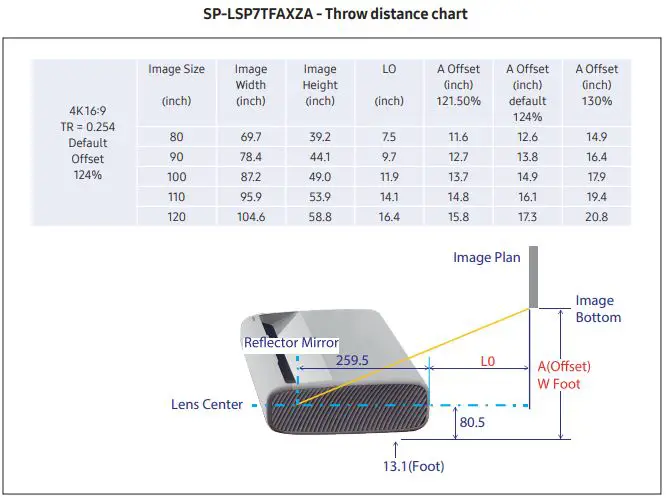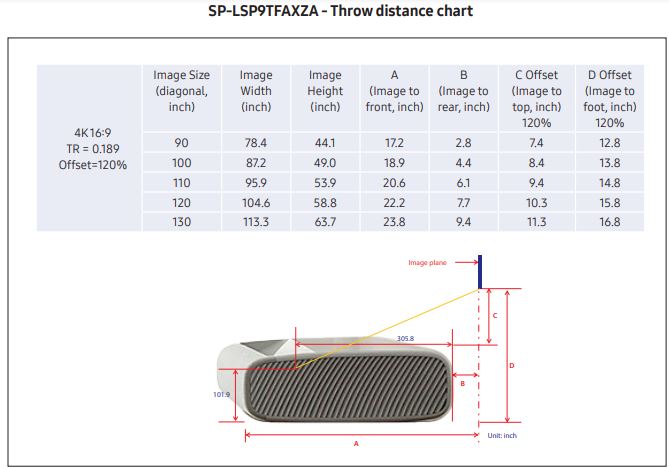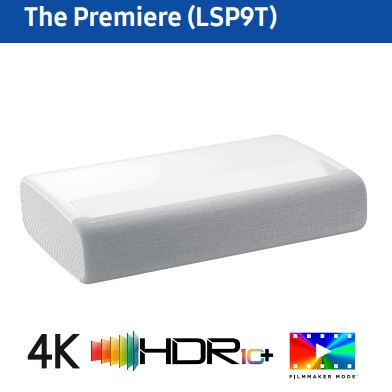Samsung has expanded its lineup of TV devices with the introduction of laser projectors in the The Premiere series. These projectors, often referred to as laser TVs, are primarily designed for video viewing. Compact and rectangular, these projectors are small yet powerful devices with the following dimensions:
Dimensions:
- LSP7T (inches W x H x D):
- Projector: 20.9 x 5.2 x 13.5
- Packaged: 26.6 x 10.1 x 18.9
- LSP9T (inches W x H x D):
- Projector: 21.7 x 5 x 14.4
- Packaged: 26.6 x 10.1 x 18.9
At the back of these devices, like traditional TVs, you’ll find ports for power, internet, HDMI, and USB connections.

What Is Samsung The Premiere and How Does It Work?
The Premiere projectors use lasers as their light source. These lasers are split into three primary colors via special lenses. The process involves:
- Laser beams hitting the mirrors of the DLP chip.
- Reflected beams being redirected 180 degrees to a projection mirror.
- The beams passing through a magnifying lens to project the image onto a surface.
This technology, developed by Texas Instruments in 2015, supports 4K resolution. Samsung entered this market in 2020, positioning these projectors as TV alternatives. Other brands like LG and Hisense have been producing similar projectors for several years.
Key Differences Between the LSP7T and LSP9T
While the two projectors look identical, their internal components differ:
- Image Size:
- LSP7T: Projects 80–120 inches.
- LSP9T: Projects 90–130 inches.
- Brightness: The LSP9T is brighter than the LSP7T, making it better suited for darkened rooms. Both models use ANSI lumens for brightness measurements, which are different from classical lumens.
- Sound:
- LSP7T: 2.2 sound format with 30W total power.
- LSP9T: 4.2 sound format with 40W total power.
Viewing Videos on the LSP7T and LSP9T
Samsung claims the projectors can display images on any white wall. However, to achieve optimal quality, the wall should be painted with special high-reflectivity paint or paired with a dedicated projector screen.
For the best viewing experience:
- Use a special screen designed for laser projectors.
- Ensure the room is darkened, as bright lighting significantly reduces image quality.
Service Life of the LSP7T and LSP9T
Samsung estimates the lifespan of these projectors to be around 20,000 hours, equivalent to two years of continuous use. Under normal conditions, they should last approximately 10 years, based on internal testing by Samsung.
Installation Distance from the Wall
The projectors need to be placed 3 to 10 inches from the wall. The distance affects the projected image size but must remain within the specified range for sharpness and clarity. For example, while moving the projector farther away might increase the image size, exceeding the recommended distance will result in a blurry image.
Below is a guide showing distances and their corresponding screen sizes.








